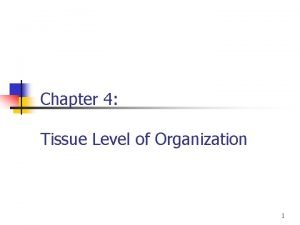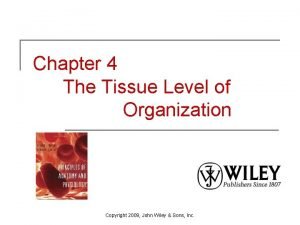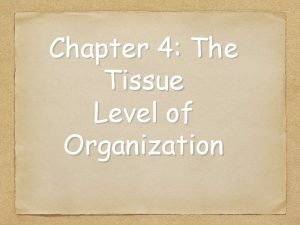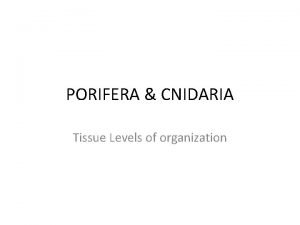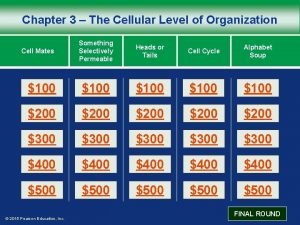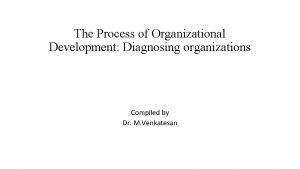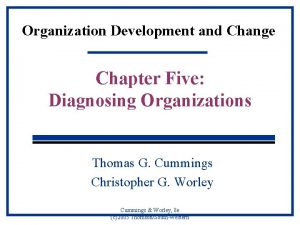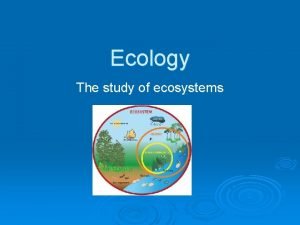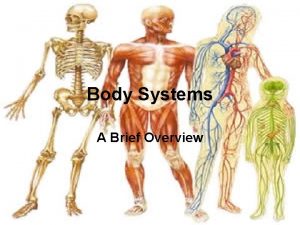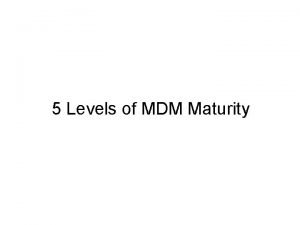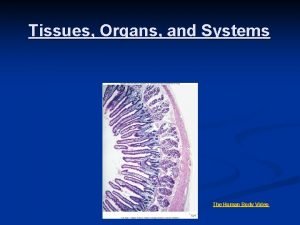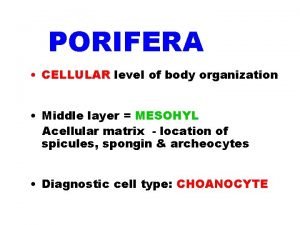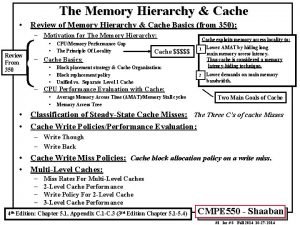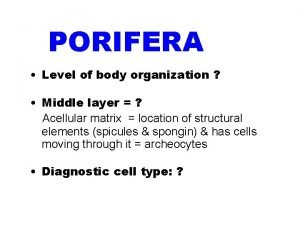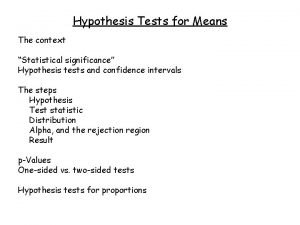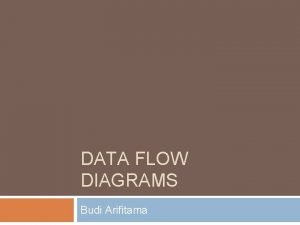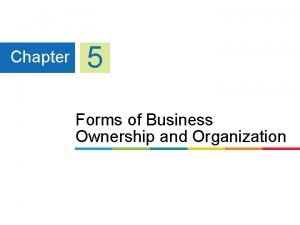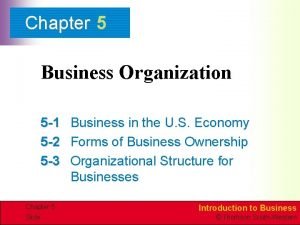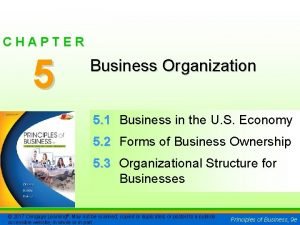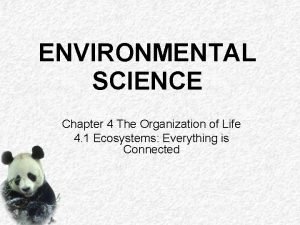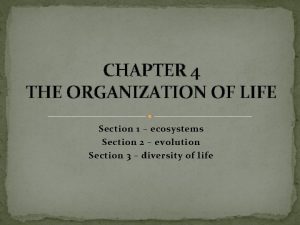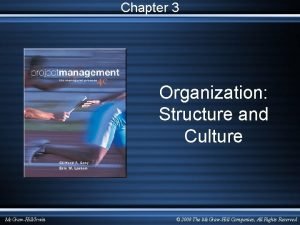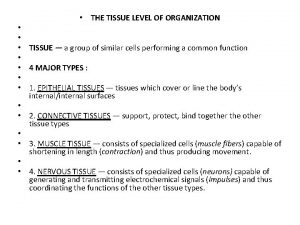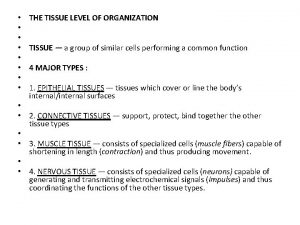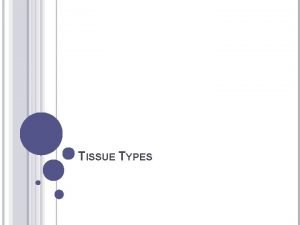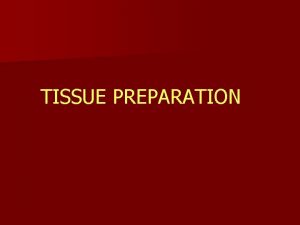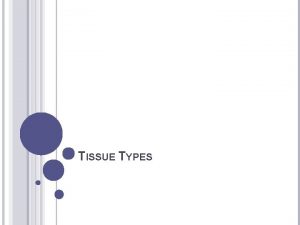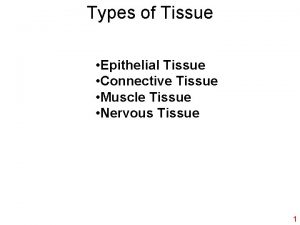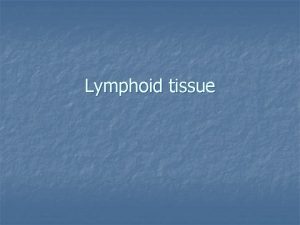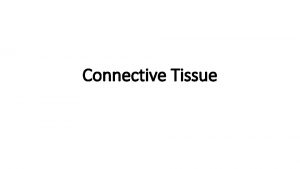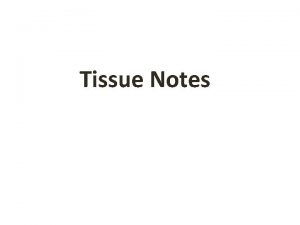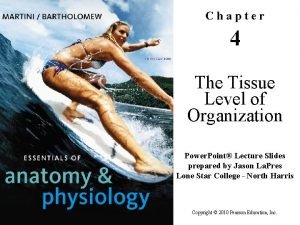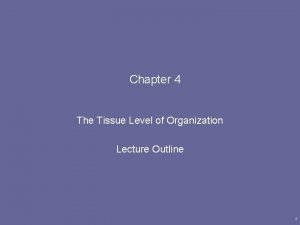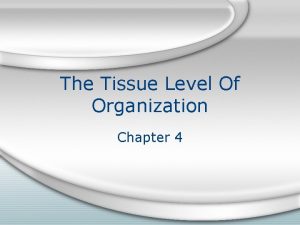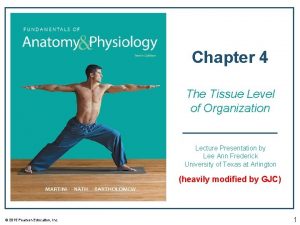Chapter 4 Tissue Level of Organization 1 Tissue













































- Slides: 45

Chapter 4: Tissue Level of Organization 1

Tissue Level of Organization n Tissues are groups of similar cells and extracellular products that carry out a common function. Histology; The study of tissue and their relationship to organs Extracellular matrix; non-cellular material outside of cells produced by living cells (ex; bone material) 4 -2

4 Types of Tissues n n epithelial tissue; surfaces connective tissue; internal: support, transport muscle tissue; movement nervous tissue; communication 4 -3

Epithelial Tissue n n n Lines every body surface and all body cavities. Forms both the external and internal lining of many organs. Constitutes the majority of glands. Composed of one or more layers of closely packed cells that form a barrier between two compartments having different components. Little to no extracellular matrix. No blood vessels penetrate an epithelium. 4 -4

Simple vs. Stratified Epithelium 5

Characteristics of Epithelial Tissue: Cellularity n n Composed almost entirely of cells bound closely together by different types of cell junctions. Minimal amount of extra-cellular matrix 4 -6

Characteristics of Epithelial Tissue: Polarity n n n Apical surface (free, or top, surface) exposed to body surface Intercellular junctions (between cells) Basal surface (fixed, or bottom, surface) attached to underlying tissue 4 -7

Characteristics of Epithelial Tissue: Attachment n The basal surface of an epithelium is bound to a thin basement membrane. 4 -8

Characteristics of Epithelial Tissue: Avascularity n n Lack blood vessels. Nutrients obtained either directly across the apical surface or by diffusion across the basal surface. 4 -9

Characteristics of Epithelial Tissue: Innervation n n Some epithelia are richly innervated to detect changes in the environment at that body or organ surface. Most nervous tissue is in the underlying connective tissue. 4 -10

Characteristics of Epithelial Tissue: Regeneration Capacity n n Frequently damaged or lost by abrasion and is replaced via high regeneration capacity. Continual replacement occurs through the divisions of the deepest epithelial cells (called stem cells) near its base. 4 -11

Functions of Epithelial Tissue n n n Protection of underlying tissues (skin) Regulation of materials into and out of the organ or tissue Produce secretions or excretions - Endocrine glands (into bodily fluids) - Exocrine glands (to body surfaces) 4 -12

Functions of Epithelial Tissue n n Sensations; nerve endings detect changes in the external environment at their surface. Continuously supply information to the nervous system concerning touch, pressure, temperature, and pain. 4 -13

Junctions There are four types of cell junctions: n tight junctions; apical surfaces, joins cells to each other (sealing surface) n adhering junctions; middle of cells, strong structural connection n Desmosomes; similar to buttons; connects adjacent cells without sealing n gap junctions; forms pores allowing materials to pass from one cell to another 4 -14

Copyright © The Mc. Graw-Hill Companies, Inc. Permission required for reproduction or display. Junctions 4 -15

Classification of Epithelial Tissue n n n Number of cell layers; - Simple; one cell layer only - Stratified; many layers (like skin) - Pseudostratified; looks like many layers due to uneven nuclei (one layer) Cell shape; - Squamous; flat - Cuboidal; square or round - Columnar; rectangular On your own and in lab; Types of Epithelium (pages 86 – 92) 4 -16

4 -17

Glands n n n Individual cells or multicellular organs that produce substances needed in or on the body May be endocrine (for use in the body) or exocrine (for use outside the body) Produce substances such as; - mucus, hormones, enzymes, and waste products 4 -18

Endocrine Glands n n Lack ducts and secrete their products directly into the interstitial fluid and/or bloodstream. Most endocrine glands produce Hormones that act as chemical messengers to influence cell activities elsewhere in the body. 4 -19

Exocrine Glands n n Usually maintain their contact with the epithelial surface by means of a duct. Duct secretes materials onto the surface of the skin or onto an epithelial surface lining an internal passageway. May be unicellular (ex: goblet cells; mucus) without ducts or multicellular (most others) with ducts Examples; sweat, milk, saliva, sebum (oil) 4 -20

Secretion Types n n n Serous glands produce and secrete a nonviscous, watery fluid, such as sweat, milk, tears, or digestive juices. Mucus glands secrete mucin, which forms mucus when mixed with water. Mixed glands, such as the two pairs of salivary glands inferior to the oral cavity, contain both serous and mucus cells, and produce a mixture of the two types of secretions. 4 -21

Merocrine Glands n n Also called eccrine glands, package their secretions in structures called secretory vesicles which travel to the apical surface of the glandular cell and release their secretion by exocytosis. The glandular cells remain intact and are not damaged in any way by producing the secretion. 4 -22

Holocrine Gland n n Secretion is produced through the destruction of the secretory cell. Lost cells are replaced by cell division at the base of the gland. 4 -23

Apocrine Gland n n Secretion occurs with the “decapitation” of the apical surface of the cell and the subsequent release of secretory product and some cellular fragments. Examples: the mammary glands and some sweat glands in the axillary and pubic regions 4 -24

Connective Tissue n n n Most diverse, abundant, widely distributed, and microscopically variable of the tissues. Designed to support, protect, and bind organs. Binds body structures together. Never found on a body surface Types; Bone, Cartilage, Blood, Loose, and Dense 4 -25

Basic Components of CT All CT share three basic components: n cells n protein fibers n ground substance 4 -26

Components of CT: Cells n n connective tissue proper contains fibroblasts, fat contains adipocytes, cartilage contains chondrocytes, and bone contains osteocytes. - Many CT’s contain white blood cells such as macrophages, which phagocytize foreign materials. 4 -27

Components of CT: Protein Fibers n n n Most contains protein fibers throughout the tissue. Strengthen and support connective tissue. Type and abundance of these fibers varies depending on function. 4 -28

Components of CT: Protein Fibers Three basic types of protein fibers: n collagen fibers are strong and stretchresistant n elastic fibers are flexible and resilient n reticular fibers form an interwoven framework n No fibers found in blood except when __? Injury occurs 4 -29

Components of CT: Ground Substance n n Cells and the protein fibers reside within a material called ground substance. Nonliving material produced by the connective tissue cells. Primarily consists of molecules composed of protein and carbohydrate and variable amounts of water. May be viscous (blood), semisolid (cartilage), or solid (bone). 4 -30

Functions of Connective Tissue n n n Physical protection Support a structural framework Binding of structures Storage Transport 4 -31

Classification of Connective Tissue n The connective tissue types present after birth are classified into three broad categories: - connective tissue proper - supporting connective tissue - fluid connective tissue 4 -32

The Resident Cells of the Connective Tissue Proper n n Fibroblasts; produce fibers and ground substance of matrix Adipocytes; fat cells Fixed macrophages; non-moving WBC’s Mesenchymal cells; stem cells that can divide and replace lost tissue 4 -33

The Wandering Cells of the Connective Tissue Proper n n Mast cells; secrete heparin (prevent clotting) and histamine (increase blood flow) Plasma cells; produce antibodies to fight pathogens Macrophages; Engulf pathogens through phagocytosis Other leukocytes; variety of other white blood cells used in immunity 4 -34

2 Broad Categories of CT n n Loose connective tissue - Areolar; common; cushions shocks - Adipose; contains fat cells - Reticular; forms framework for many organs Dense connective tissue (Primarily protein fiber) - Dense regular; parallel fibers (tendons) - Dense irregular; fibers in all directions (dermis) - Elastic; branching elastic fibers (vocal cords and ligaments) 4 -35

Supporting Connective Tissue n n n Cartilage and bone Form a strong, durable framework that protects and supports the soft body tissues. Extracellular matrix contains many protein fibers and a ground substance that ranges from semisolid to solid. 4 -36

Cartilage n n n Firm extra cellular matrix of protein fibers and ground substance Living cells called chondrocytes Chondrocytes live in spaces called lacuna Stronger and more flexible than other types of connective tissue Found in areas of the body that need flexible support and cushioning (like in joints and at the tip of your nose) On your own and in lab; Types of Cartilage (pages 106 -107) 4 -37

Bone n n n Also known as osseus tissue More rigid and inflexible than cartilage One third organic materials - primarily collagen fibers (resists cracking) Two thirds inorganic components - primarily calcium salts (like calcium phosphate) - calcium provides compression (weight-bearing) strength (think of reinforced concrete) Possesses a periosteum; connective tissue layer surrounding the bone On your own and in lab; Types of Bone tissue and structures (pages 106 -107) 4 -38

Blood: Fluid Connective Tissue Blood is a fluid connective tissue composed of cells called formed elements. n erythrocytes (red blood cells) n leukocytes (white blood cells) n platelets - erythrocytes transport oxygen and carbon dioxide between the lungs and the body tissues - leukocytes mount an immune response - platelets are involved with blood clotting 4 -39

Muscle Tissue n n n Responds to stimulation from the nervous system causing them to shorten. Produce voluntary and involuntary movement. Types; - Skeletal; striated, used for voluntary movements, usually attached to bones - Cardiac; striated with intercalated discs, involuntary, found in heart - Smooth; involuntary, found in skin and internal organs such as small intestine, stomach 4 -40

4 -41

Nervous Tissue n n Sometimes termed neural tissue. Consists of neurons, or nerve cells, and glial cells that support, protect, and provide a framework for neurons. 4 -42

Neurons n n Detect stimuli, process information quickly, and rapidly transmit electrical impulses from one region of the body to another. Prominent cell body functions in control; information processing, storage, and retrieval; internal communication. 4 -43

Neurons n Processes extend from the nerve cell body. - Dendrite; incoming signals to neuron - Axon; outgoing signals from neuron 4 -44

On your own; n Tissue Change, Repair, and Death; pages 112 - 115 4 -45
 Chapter 4 the tissue level of organization
Chapter 4 the tissue level of organization Chapter 4 the tissue level of organization
Chapter 4 the tissue level of organization Chapter 4 the tissue level of organization
Chapter 4 the tissue level of organization Porifera tissue organization
Porifera tissue organization Chapter 3 the cellular level of organization
Chapter 3 the cellular level of organization Chemical level of organization
Chemical level of organization The chemical level of organization chapter 2
The chemical level of organization chapter 2 Process organization in computer organization
Process organization in computer organization Block arrangement compare and contrast
Block arrangement compare and contrast How is aerolar tissue different than aerenchyma tissue?
How is aerolar tissue different than aerenchyma tissue? Organization level
Organization level Organization-level diagnostic model
Organization-level diagnostic model Organization level
Organization level What is the least complex level of organization
What is the least complex level of organization Level of organization in ecology
Level of organization in ecology Level of organization organ system
Level of organization organ system Level of mdm
Level of mdm Smallest to largest level of organization
Smallest to largest level of organization Porifera level of organisation
Porifera level of organisation Mis system examples
Mis system examples Three level cache organization
Three level cache organization What level of organization
What level of organization Various levels of management
Various levels of management Levels of ecological organization
Levels of ecological organization Porifera
Porifera A pyramid of illustrates the relative amount
A pyramid of illustrates the relative amount Molecular level vs cellular level
Molecular level vs cellular level Isis level 1 vs level 2
Isis level 1 vs level 2 How to interpret confidence intervals example
How to interpret confidence intervals example Isis level 1 vs level 2
Isis level 1 vs level 2 What is the interpretation of a 96 confidence level
What is the interpretation of a 96 confidence level Confidence level and significance level
Confidence level and significance level Dfd level 0
Dfd level 0 Piramida level keamanan informasi memiliki berapa level
Piramida level keamanan informasi memiliki berapa level Examples of costa's level 1 questions
Examples of costa's level 1 questions Thread-level parallelism
Thread-level parallelism Rcp hlsl
Rcp hlsl Sacss
Sacss The organization of congress chapter 5
The organization of congress chapter 5 Chapter 5 business organization
Chapter 5 business organization Chapter 5
Chapter 5 Chapter 5 business organization
Chapter 5 business organization Environmental science chapter 4 the organization of life
Environmental science chapter 4 the organization of life Chapter 4 the organization of life section 1
Chapter 4 the organization of life section 1 Organization and management chapter 3 planning
Organization and management chapter 3 planning Organizational culture diagnosis worksheet
Organizational culture diagnosis worksheet
